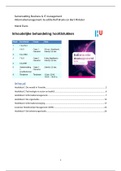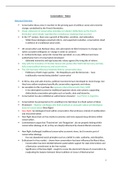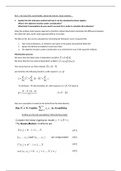Chapter 5
Equity and social welfare
Introduction:
Relevant implications from the two-sector model:
- A competitive economy producing the output mix at C will not necessarily yield the
most preferred distribution of income.
o May occur at point S.
- Policy-induced movement along the PPC (from C to S) will necessarily change the
distribution of income.
o Therefore, places one individual in a worse position compared to the other.
Quantity of good Y
M0 C
S
N0 Quantity of good X
Criteria for assessing welfare effects of public policy:
- Pareto criterion → implies that policy-induced change is justified only if it will
improve the well-being of at least one person without harming that of another.
o Focuses on individual welfare.
- Bergson criterion → allows for welfare improvement even if one or more individuals
are harmed in the process.
o Less strict than pareto criterion.
o Focuses on average welfare.
o Can harm individual welfare provided that societal welfare as a whole is not
harmed.
Nozick’s entitlement theory:
- Provides Pareto-based justification for redistributive policies aimed at redressing
past injustices.
Pareto criterion → associated with libertarian approach to public policy.
- Libertarian approach → individual freedom is the primary goal of the community.
o Maximisation of “negative freedom” or protection of the right to not be
forced by others. → exercising your right in a way that does not infringe those
of others.
Notes by Georgia Taylor EKN 310 1
, o Libertarians → opposed to distributional policies that infringe upon individual
freedom.
o Advocates a laissez faire system → governments role is reduced to the
responsibility of protecting individual freedom (caretaking role).
Nozick’s entitlement theory → exception to the libertarian rule
Principles of justice under entitlement theory:
1. Justice in acquisition → individuals are entitled to acquire things that do not belong
to others or do not place others in a worse position than before.
o Things = property and capital goods only.
o E.g house does not belong to anyone else when you acquire ownership of it
and nobody is worse off now that you own it.
2. Justice in transfer → material things can be transferred from individual to another on
a voluntary basis.
o E.g grants, gifts, bequests, and voluntary exchange
o Nobody is being forced to participate in the transaction.
3. Rectification of justice I holdings → redistribution of wealth is potentially justified only
if one or both of the above two principles have been violated.
o E.g you take a property that belonged to someone else, and they did not
consent to the transfer of you owning it.
The third principle is the only justification for a policy aimed at redistribution of resources
between individuals.
These principles formed a cornerstone of investigations undertaken by the Truth and
Reconciliation Commission (TRC) → limited its focus to the apartheid era during which the
National Party was in power.
Other Pareto criteria:
Policies aimed at redistributing income from rich to poor people → justified on Pareto
grounds on basis of addressing externalities.
- High degree of inequality → poor impose negative externalities on the rich
o E.g high levels of poverty lead to high levels of crime and violence → these
undermine the quality of live of the rich.
o E.g lack of sanitation and other health-promoting services among the poor
can cause contagious diseases → threaten the health of the rich
o As a solution → the rich might transfer part of their income to the poor →
potentially reduces negative external effects impacting them.
o Government policies of redistribution: direct transfer payments or indirect
support by providing basic services etc.
- Insurance motive → individuals may view their tax payments as an inexpensive
means of insuring themselves against future loss of income or ill-health → see tax as
a superior and cheater alternative to private insurance.
o E.g if they become unemployed → they state will provide support for them
from the UIF.
o E.g if they become ill → they can receive care at a state-owned facility.
Notes by Georgia Taylor EKN 310 2
Equity and social welfare
Introduction:
Relevant implications from the two-sector model:
- A competitive economy producing the output mix at C will not necessarily yield the
most preferred distribution of income.
o May occur at point S.
- Policy-induced movement along the PPC (from C to S) will necessarily change the
distribution of income.
o Therefore, places one individual in a worse position compared to the other.
Quantity of good Y
M0 C
S
N0 Quantity of good X
Criteria for assessing welfare effects of public policy:
- Pareto criterion → implies that policy-induced change is justified only if it will
improve the well-being of at least one person without harming that of another.
o Focuses on individual welfare.
- Bergson criterion → allows for welfare improvement even if one or more individuals
are harmed in the process.
o Less strict than pareto criterion.
o Focuses on average welfare.
o Can harm individual welfare provided that societal welfare as a whole is not
harmed.
Nozick’s entitlement theory:
- Provides Pareto-based justification for redistributive policies aimed at redressing
past injustices.
Pareto criterion → associated with libertarian approach to public policy.
- Libertarian approach → individual freedom is the primary goal of the community.
o Maximisation of “negative freedom” or protection of the right to not be
forced by others. → exercising your right in a way that does not infringe those
of others.
Notes by Georgia Taylor EKN 310 1
, o Libertarians → opposed to distributional policies that infringe upon individual
freedom.
o Advocates a laissez faire system → governments role is reduced to the
responsibility of protecting individual freedom (caretaking role).
Nozick’s entitlement theory → exception to the libertarian rule
Principles of justice under entitlement theory:
1. Justice in acquisition → individuals are entitled to acquire things that do not belong
to others or do not place others in a worse position than before.
o Things = property and capital goods only.
o E.g house does not belong to anyone else when you acquire ownership of it
and nobody is worse off now that you own it.
2. Justice in transfer → material things can be transferred from individual to another on
a voluntary basis.
o E.g grants, gifts, bequests, and voluntary exchange
o Nobody is being forced to participate in the transaction.
3. Rectification of justice I holdings → redistribution of wealth is potentially justified only
if one or both of the above two principles have been violated.
o E.g you take a property that belonged to someone else, and they did not
consent to the transfer of you owning it.
The third principle is the only justification for a policy aimed at redistribution of resources
between individuals.
These principles formed a cornerstone of investigations undertaken by the Truth and
Reconciliation Commission (TRC) → limited its focus to the apartheid era during which the
National Party was in power.
Other Pareto criteria:
Policies aimed at redistributing income from rich to poor people → justified on Pareto
grounds on basis of addressing externalities.
- High degree of inequality → poor impose negative externalities on the rich
o E.g high levels of poverty lead to high levels of crime and violence → these
undermine the quality of live of the rich.
o E.g lack of sanitation and other health-promoting services among the poor
can cause contagious diseases → threaten the health of the rich
o As a solution → the rich might transfer part of their income to the poor →
potentially reduces negative external effects impacting them.
o Government policies of redistribution: direct transfer payments or indirect
support by providing basic services etc.
- Insurance motive → individuals may view their tax payments as an inexpensive
means of insuring themselves against future loss of income or ill-health → see tax as
a superior and cheater alternative to private insurance.
o E.g if they become unemployed → they state will provide support for them
from the UIF.
o E.g if they become ill → they can receive care at a state-owned facility.
Notes by Georgia Taylor EKN 310 2










